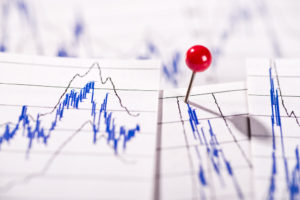
By Kristen Taylor, MSFA
Research Analyst
This month, Mission Wealth’s Research Analyst Kristen Taylor participated in an Investor Roundtable – a part of the Fall Economic Forecast special report in the Pacific Coast Business Times. The report contained roundtable discussions with investment advisers and wealth managers. This economic indicators update took a look at employment trends in region, the latest data on housing and jobs in the Tri-Counties, and a look at the performances of the region’s publicly traded companies.
In this article Kristen gives some insight to what the market has in store, weighing in on the socially responsible investing trend and, now nearly 10 years later, what the market has learned from the 2008 housing crisis.
1. What do the high bond yields across the 10-year and 30-year Treasury issues signal? Can these sustain or do you see a drop off? And while we’re on the subject, what is your expectation for future Fed rate hikes.
We feel that even with the recent rise in Treasury bond yields, they are still low by historical standards, and will continue to follow movement in the Fed Funds rate, which the Fed has communicated they intend to continue to increase. This could also be a signal for other central banks that may follow the US trajectory with tighter monetary policy in the coming years. Also, with the Treasury yield curve relatively flat compared to historic rates, especially on the longer maturities, any further flattening could move towards an inverted yield curve – historically an inversion has been a leading indicator of a recession to a varied degree, though remains an imperfect predictor as the time between an inverted yield curve and the beginning of a recession has varied significantly.
With regard to future Fed rate hikes, we feel that the Fed will continue to tighten, assuming labor market conditions are strong and inflation remains a slow-grower for the next 15 months, to raise the Fed Funds rate once more this year and likely at least another three times in 2019 (25bps each). Should inflation spike in the next year, the Fed could accelerate rate hikes, or if there is a market correction triggered by headwinds like the global trade war they might pause raising the rate further.
2. What effect do you see the U.S.-China trade war will have on a fixed, equity or balanced portfolio? Are we in a trade war or is this just a skirmish?
Only time will determine whether the trade war as a real risk to the global economy or a skirmish, but tensions have already impacted various sectors, such as international markets and more specifically emerging markets. International economies in general are more reliant on global trade than the US. The US is a relatively “closed economy” by global standards: it is not as reliant on exports as a key driver of economic growth, so any negative headline that surrounds global trade will have a larger effect on more “open economies” like China, Canada and Mexico.
In the US specifically, publicly traded stocks have had the benefit of corporate tax reform to help offset the potential negative headwinds from imposed tariffs. Also, there could be a 6-12 month lag between imposition of a tariff and its impact on the economy. Increased tariffs inflate the cost of imported goods and materials; businesses facing this price pressure have the choice to either stomach the increase themselves and take the hit to the bottom line, or pass these increases on to consumers in the form of higher end good prices. The former may negatively impact business earnings, while the latter could lead to inflation and a negative impact on demand. The threat of tariffs may also negatively impact business investment. The uncertainty surrounding potential tariffs may lead to businesses postponing or even avoiding investment projects that may be potentially impacted. After all, no one wants to embark on a large-scale project when there is a real risk of a material change in cost structure halfway in.
At Mission Wealth we feel a well-diversified and balanced portfolio should fare well despite headwinds such as the global trade war, as an allocation across multiple assets classes can reduce correlation and reduce the impact from any one piece of the overall portfolio negatively affected by these external forces. 
Lastly, investor behavior can have a large impact on market movement, especially when decisions are driven by fear from uncertainty. Given that for many companies the material impact of imposed tariffs has yet to occur, much of the movement in asset prices indicates anticipatory decisions attempting to lower investor exposure to potential risks down the road.
3. What strategies do you see as particularly effective when investors want to integrate socially responsible stock into their portfolio? What will be the longer-term effect of investor activism?
The simplest strategy towards integrating socially responsible strategies (in stocks or bonds) is to start by screening out sectors the investor would personally want to avoid (popular industries include, tobacco, gambling, weapons, oil/gas, etc). In addition, proactively focusing on companies or funds that have high Environmental, Social, Governance (ESG) scores or a socially conscious theme. This type of strategy allows the investor to incorporate non-financial risk analysis into their portfolios with an awareness of investments that are mitigating risks associated with climate change/natural resources, pollution/waste, human capital, product liability, stakeholder opposition, and corporate governance/behavior.
Taking one’s socially responsible strategy one step further would include a focus on proactively impactful investments, i.e. companies or fund managers holding the intention to not only avoid controversial industries or low ESG scores, but to create monetary and non-monetary measurable value through anything from sustainable energy and water technologies to job creation and reducing poverty.
In small strides, we are already seeing investor activism create incremental shifts in how certain companies/industries operate. Some ESG rating firms indicate strong growth in reverse inquiry, i.e. companies wanting to know how they can improve their scores, which is driven by investor demand to receive more transparency in these non-financial metrics. We believe companies will pay increasing attention to all of their stakeholders who have a growing voice, especially as highly relevant topics like resource efficiency in real estate for example, play bigger roles in how investors consider where to invest.
4. We are just about 10 years from the collapse of Lehman Brothers. What were the top lessons learned? Where are their persistent weaknesses?
-
- Whether it was the Lehman Brothers collapse, the cryptocurrency craze or the dot com boom, investor behavior will continue to operate in a similar (at times erratic) fashion because we as humans are inherently irrational beings. This can result in anything from an emotionally driven decision to buy into a bubble (herding) or executing a fear-driven decision when volatility increases or a downturn occurs.
-
- The crash in 2008 can also demonstrate when a market can possibly overreact to news, and for those willing to dive in (or hold on) while others are running for the exit, could potentially be a great investment if they are able and willing to stomach the aftershocks. Taking a disciplined approach and a long term view that the market/economy will eventually recover within one’s time horizon, can be a strategy with potential on the other side of a crisis. Investors cannot avoid market land mines though, and if one could predict the next market correction, pinpointing the severity is even more difficult, so preparing for uncertainly is important.

-
- Economies and financial markets are highly complex so we are still continuing to unravel some of the underlying contributors of what happened in 2008, and therefore should expect many more years before we fully understand all the causes and effects of the crisis. Visible changes like bank underwriting standards have improved since the years leading up to the crisis, and it is believed that levels of excesses in the economy aren’t what they were ten years ago, so one could consider that should a recession develop, it may not be as severe.
-
- Immediately following the Great Recession, some pundits believed that many of our banks would disappear, securitized lending products would evaporate, and inflation would soar given the extraordinary amount of quantitative easing, which clearly has not been the case, indicating predictions of crisis recoveries can be a challenge. There have in fact been pockets of opportunities, as markets evolve and adapt, like the growth of the direct lending sector now that banks have tightened their lending standards.
Weakness could lie in the growing complacency of investors and the ever-debated question as to whether the stock/bond markets are justified in their rate of ascent in recent years. Catalysts like a looming global trade war can also push investor behavior to make quick changes to their portfolios, which could lead to increased volatility. Also, in the private equity world, and even in some public technology companies, exaggerated valuations are being questioned, especially for companies that are barely profitable and therefore should be observed with a cautious eye.
5. With U.S. stocks trading at record highs, and with talks of opportunities outside America, what does the revision to the Global Industry Classification Standard have in store for the market?
At a high level, we feel this is merely a shift of companies from one classification bucket to another. The biggest indexes have not indicated any material additions or subtractions to their holdings, and weights should remain the same. We would expect to see some minor shifts in sector funds, especially technology focused, to follow the reclassification, but nothing that should affect performance of a well-diversified portfolio.
There is some speculation that a few of the “somewhat forgotten” telco companies may receive some revived attention in becoming more prominent names in the new sectors, and the GICS change might reduce headlines around the outperforming technology sector, but we don’t anticipate any foreseeable material effects on market levels.
6. What are your predictions on the S&P 500 and the 10-year Treasury yield at year-end?
As a purely speculative prediction, we estimate the S&P 500 to be in the range of 3020-3050, and the 10 year Treasury to be in the 3.10-3.15% range.
To view the 2018 Pacific Coast Business Times report of roundtable discussions with regional economists, top leaders in philanthropy, investment advisers and wealth managers, visit https://www.pacbiztimes.com/special-sections-events/. This economic indicators update will look at employment trends in region, the latest data on housing and jobs in the Tri-Counties, and a look at the performances of the region’s publicly traded companies.
1069704 10/18
READ MORE:
Investing in 2018: Tuning Out the Noise
Avoid Being An Average Investor: 7 Rules
New Alliance Spurs Social Investments
Disclaimer that past performance is not an indication of the future and that there are no guarantees with investing.

